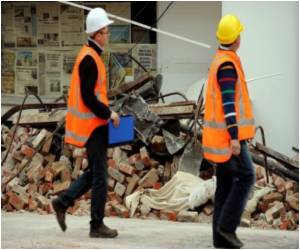The New Zealand city's magnificent Gothic revival cathedral hewn from local basalt was irreparably damaged in the 6.3-magnitude earthquake that claimed 185 lives on February 22 last year.

Urgently needing a temporary replacement, the Anglican Church commissioned Ban -- who donated his services gratis -- to draw up plans for a place of worship to house Christchurch's faithful.
The result is the so-called cardboard cathedral now taking shape on the quake-scarred city's skyline.
Built from 600-millimeter (24-inch) diameter cardboard tubes coated with waterproof polyurethane and flame retardants, it will be a simple A-frame structure that can hold 700 people.
"It will be a huge milestone towards recovery for Christchurch," project manager Johnny McFarlane said.
"It's going to be a great building to walk into, it's very light and airy and gives a good sense of dominance and scale."
Advertisement
While the 55-year-old takes on major commercial projects such as office buildings and tourist resorts, he is also a pioneer in "emergency architecture" which can be rapidly erected in disaster zones.
Advertisement
"This is part of my social responsibility," he told AFP. "Normally we (architects) are designing buildings for rather privileged people ... and they use their money and power for monumental architecture".
"But I believe we should build more for the public... people who have lost their houses through natural disaster."
He said many so-called natural disasters such as earthquakes were worsened by the failure of man-made structures and architects had an obligation to help.
"People are not killed by earthquakes, they're killed by collapsing buildings," he said.
"That's the responsibility of architects but the architects are not there when people need some temporary structure because we're too busy working for (the) privileged. Even a temporary structure can become a home."
A common feature of Ban's emergency architecture is the use of recycled material, including shipping containers and beer crates, which were filled with sandbags to act as shelter foundations after the 1995 Kobe earthquake.
But his signature material is cardboard tubes, which he says are readily available after disasters, unlike traditional materials such as timber and steel.
He has used them to build everything from a concert hall in L'Aquila, Italy, a schoolhouse in China's Chengdu and a "paper church" in Kobe, which was erected in just five weeks.
"The material is available everywhere in the world," he said. "Even when I was building a refugee shelter in Rwanda I found the paper I needed for my structure in Kigali".
"So anywhere I can go I can find this material, it's very inexpensive and normally this is not a building material, so it's easy to get in the emergency period. It's also lightweight and cheap."
Christchurch's new cathedral, due to be completed in April next year -- 132 years after the consecration of the original stone version -- is the largest cardboard structure Ban has designed.
The church, insurance and public donations are paying for the NZ$5 million project ($4.2 million) for which local builders have offered discount prices.
It has a concrete base, with the cardboard tubes forming two sides of the A-frame and containers helping brace the walls.
One end of the cathedral will be filled with stained glass and a polycarbon roof will help protect it from the elements, giving a lifespan estimated at 50 years.
Church authorities envisage it being used as a cathedral for only 10 years, until a permanent replacement is built, although Ban said the enthusiastic response in New Zealand to his innovative plans could change that.
"If people love it, it will be permanent, I hope that's going to happen," he said.
Building authorities in Christchurch pored over the plans and declared they fully meet earthquake standards, while even locals initially sceptical about the cardboard concept have been won over.
"I thought it was a bit of a strange idea but now I think it's really cool," Christchurch resident Hunter McKenzie said.
"It's actually good just to get the cathedral up and running and try to get the city back to normal."
Source-AFP









